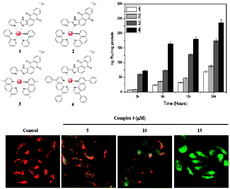The induction of mitochondria-mediated apoptosis in cancer cells by ruthenium(ii) asymmetric complexes
Abstract
Four ruthenium(II) asymmetric complexes, [Ru(bpy)2(PAIDH)]2+ (bpy = 2,2′-bipyridine, PAIDH = 2-pyridyl-1H-anthra[1,2-d]imidazole-6,11-dione, 1), [Ru(phen)2(PAIDH)]2+ (phen = 1,10-phenanthroline, 2), [Ru(dmp)2(PAIDH)]2+ (dmp = 4,7-dimethyl-1,10-phenanthroline, 3) and [Ru(dip)2(PAIDH)]2+ (dip = 4,7-diphenyl-1,10-phenanthroline, 4), have been synthesized and characterized. These complexes displayed potent anti-proliferation activity against various cancer cell lines and had high selectivity between tumor cells and normal cells. HeLa cells exhibited the highest sensitivity to complex 4, accounting for the greatest cellular uptake. Complex 4 was shown to accumulate preferentially in the mitochondria of HeLa cells and induced apoptosis via the mitochondrial pathway, which involved ROS generation, mitochondrial membrane potential depolarisation, and Bcl-2 and caspase family members activation. These results demonstrated that complex 4 induced cancer cell apoptosis by acting on mitochondrial pathways.

- This article is part of the themed collection: Metallomics in China

 Please wait while we load your content...
Please wait while we load your content...